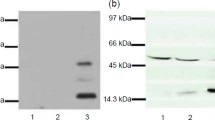Abstract
The effects of AAV-TGFβ1 and AAV-TGFβ3 on promoting synthesis of glycosaminoglycan and collagen type II of dedifferentiated rabbit lumbar disc NP cells were studied in this work. The rabbit lumbar disc NP cells were isolated and cultured. The earlier and later dedifferentiated NP cells were established by subculture. The AAV transfection efficiency to dedifferentiated NP cells was analyzed with AAV-EGFP in vitro. After dedifferentiated NP cells were transfected by AAV-TGFβ1 or AAV-TGFβ3, their biological effects on promoting synthesis of glycosaminoglycan or collagen type II were detected and compared by the methods of 35S incorporation or immunoblotting. The experimental results showed that AAV could transfect efficiently the earlier dedifferentiated NP cells, but its transfection rate was shown to be at a low level to the later dedifferentiated NP cells. Both AAV-TGFβ1 and AAV-TGFβ3 could promote the earlier dedifferentiated NP cells to synthesize glycosaminoglycan and collagen type II, and the effect of AAV-TGFβ1 was better than that of AAV-TGFβ3. For the later dedifferentiated NP cells, the AAV-TGFβ3 could promote their synthesis, but AAV-TGFβ1 could slightly inhibit their synthesis. Therefore, AAV-TGFβ1 and AAV-TGFβ3 could be used for the earlier dedifferentiated NP cells, and the TGFβ3 could be used as the objective gene for the later dedifferentiated NP cells.
Similar content being viewed by others
References
Wehling P, Schulitz K P, Robbins P D, et al. Transfer of genes to chonduocytic cells of the lumbar spine—Proposal for treatment strategy of spinal disorders by local gene therapy. Spine, 1997, 22:1092–1097
Nishida K, Kang J D, Gilbertson L G, et al. Modulation of the biologic activity of the rabbit intervertebral disc by gene therapy: An in vivo study of adenovirus-mediated transfer of the human transforming growth factor beta 1 encoding gene. Spine, 1999, 24: 2419–2425
Howard S A, Eugene J M, Thonar P, et al. Biological repair of intervertebral disc. Spine, 2003, 28(15s): s86–92
Yang Y, Nunes F A, Berencsi K, et al. Cellular immunity to viral antigens limits E1-deleted adenoviruses for gene therapy. Proc Natl Acad Sci USA, 1994, 91: 4407–4411
Ji A Y, Hu T G, Tan J W, et al. Adenovirus-mediated transfer of TGF-β1 encoding gene to the nucleus puiposus cells of lumbar disc of the rabbit: The effect on proteoglycan level. Chin J Orthop, 2002, 22(10): 630–633
Monahan P E, Samulski R J. Adeno-associated virus vectors for gene therapy: more pros than cons? Mol Med Today, 2000, 6: 433–440
Rabinowitz J E, Samulski R J. Adeno-associated virus expression systems for gene transfer. Curr Opin Biotechnol, 1998, 9: 470–475
Kingston P A. Adenovirus-mediated gene transfer of transforming growth factor-β3, but not transforming growth factor-β1, inhibits constrictive remodeling and reduces luminal loss after coronary angioplasty. Circulation, 2003, 108: 2819–2831
Duke P T, Hansen P, Iwata K K, et al. Identification of another member of the transforming growth factor type β gene family. Biochemistry, 1988, 85: 4715–4719
Sai J M, Hu Y G, Wang D C H. Establishing the earlier and advanced dedifferentiated nucleus pulposus cells and detecting AV-TGFβ1 effect on proteoglycan synthesis. J Cervicodynia and Kumbodynia, 2006, 27(6): 455–458
Chen Y, Hu Y G, Lv Z H. Regulating effects of transforming growth factor-beta (TGF-β) on gene expression of collagen type II in human intervertebral discs. Chin J Surg, 2000, 38(9): 703–706
Chen Y, Hu YG, Qi ZH, et al. The regulation effect of transforming growth factor β ( TGF-β) on gene expression of collagen type I in the human intervertebral discs. Orthop J Chin, 2000, 7(2): 151–153
Chen Y, Hu Y G, Liu Y. The research about the dedifferentiation of the intervertebral disc cells in vitro culture. Chin J Spine Spinal Cord, 2000, 10(3): 188–189
Tan Y B, Hu Y G, Tan J W, et al. Extracellular matrix synthesis and ultrastructural changes of degenerative disc cells transfected by AD/CMV-TGF-β1. Chin Med J, 2003, 116(9): 1399–1403
Smith-Arica J R, Bartlett J S. Gene therapy: recombinant adeno-associated virus vectors. Gene Therapy for Cardiovascular Disorders, 2001, 3(1): 43–49
Yan C H, Luk K D K, Cheung K M C, et al. Gene therapy for bone formation using adeno-associated viral bone morphogenetic protein-2 vectors. Gene Ther, 2003, 10: 1345–1353
Antoniou J, Steffen T, Nelson F, et al. The human lumbar intervertebral disc: Evidence for changes in the biosynthesis and denaturation of the extracellular matrix with growth, maturation, aging and degeneration. J Clin Invest, 1996, 98: 996–1003
Kaapa E, Han X, Holm S, et al. Collagen synthesis and types I, III, IV, and VI collagens in an animal model of disc degeneration. Spine, 1995, 20: 59–66
Matsunaga S, Nagano S, Onishi T, et al. Age-related changes in expression of transforming growth factor-beta and receptors in cells of intervertebral discs. Spine, 2003, 28(5): 446–454
Chen Y, Hu Y G, Lv Z H. The regulating effects of transforming growth factor β (TGF-β) on gene expression of collagen types I, III in the human intervertebral discs. Chin J Orthop, 1999, 19(10):610–613
Author information
Authors and Affiliations
Corresponding author
Additional information
Supported by the National Natural Science Foundation of China (Grant No. 30271318)
Rights and permissions
About this article
Cite this article
Sai, J., Hu, Y. & Wang, D. Effects of adeno-associated virus (AAV) of transforming growth factors β1 and β3 (TGFβ1,3) on promoting synthesis of glycosaminoglycan and collagen type II of dedifferentiated nucleus pulposus (NP) cells. SCI CHINA SER C 50, 605–610 (2007). https://doi.org/10.1007/s11427-007-0066-5
Received:
Accepted:
Issue Date:
DOI: https://doi.org/10.1007/s11427-007-0066-5




